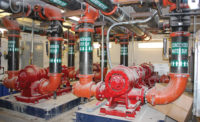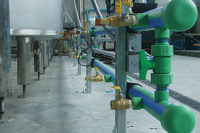
Forced
to divide mechanical equipment into two very small closets, Mountain
Seas Development used polypropylene piping to navigate space in this
Utah renovation and avoid the need for power blowers to cool the pair
of spaces.
When Mountain Seas Development planned to renovate its historic building located in downtown Park City, UT, space-conscious design was imperative. Since the building sits on extremely valuable land on Main Street, every square foot was precious.
Mountain Seas sought to update the building’s existing retail space and build an addition for a three-level apartment above it. Additionally, the building’s listing in the historical registry made the project challenging.
Since the renovation would require breaking ground for new retail space in the basement and adding the apartment, the project’s general contractor, Al Coelho, foresaw that the project’s main problem would be fitting all of the necessary mechanical equipment into a tight mechanical room.
A TIGHT SPOT
Typically, one 6-ft by x 6-ft room would have been necessary for all of the mechanical equipment, but Mountain Seas couldn’t spare that much space. A consensus was reached to put all of the mechanical equipment for the 6,500-sq-ft building into two small closets.Copper would typically have been used to connect all the equipment, however, Ryan Bateman, Mountain Seas’ project manager, was concerned with the temperature of the mechanical room. The heat emitted from copper piping would raise the room’s temperature, causing the boiler to run inefficiently and also potentially causing damage. “Copper piping would have required power blowers for venting to exhaust the heat emitted from the copper pipes,” Bateman said.
Carl Pond, owner of Carl Pond Plumbing & Heating Inc., which served as the job’s mechanical contractor, advised that copper was not a good fit. “Soldering the copper joints would have been a major fire hazard in such a tight spot. Plus, it was a finished room and they wanted to leave it finished. Using an open flame in that small room would have been a big deal.”
One of the mechanical rooms serves the stores and common areas of the building and is only 5-ft by 3-ft. Located under the stairwell in the basement, it includes a 250,000-Btuh Triangle Tube Prestige condensing boiler and a Triangle SMART 40-gal indirect-fired water heater for the public bathrooms and office bathrooms. The boiler provides 2,913 sq ft of radiant heating, 200 sq ft of snow melt, and heat to a 20,000 Btuh fancoil for the stairwell.
Located in the middle of the three-story apartment, the second mechanical room is 3 ft by 3 ft and includes another Triangle condenser. The boiler serves 1,221 sq ft of radiant floor heat, 483 sq ft of snow melt decks, and 15 sq ft of roof snow melt around roof drains, with a Triangle SMART 60-gal indirect-fired water heater. All systems are fully automated and individually controlled for energy efficiency.
Each system has multiple Grundfos pumps for zoning, and domestic hot water with Taco pump controls.
NO FANTASY - A DREAM PIPE
Pond, a plumber with over 30 years of experience, suggested using Aquatherm’s polypropylene-random (PP-R) piping. “Aquatherm was the perfect option for this project. Aquatherm Greenpipe®, which is used for potable water, and Climatherm, which is used for heating and cooling, were a superb alternative to copper.”In the cramped mechanical closet, running the pipes would mean a lot of connections - and the possibility of leaks. The Aquatherm heat fusion process is much simpler than the soldering of copper pipes.
Two identical pieces of plastic are heated using a 500ºF welding iron and then joined under moderate pressure. With no flames, chemicals, or mechanical connections, the joints are seamless, virtually eliminating the chance for leaks and corrosion. Also, Aquatherm’s PP-R has an R-value of 1, thus reducing the heat emitted from the pipes and negating the need for power blowers - a big savings on time, space, and money.
The mechanical room was finished using 1/2- to 1-1/2-in. Climatherm piping. The room was so small that they could only fit one person in the room (and barely do that once the equipment was in place) at a time.
Luckily, the headers could be prefabricated and the final connections were then made inside the room. The piping easily passed inspection and the Park City inspectors were impressed with the project and Aquatherm.
The project was completed in March 2009. According to Coelho, the total mechanical estimate of $112,000 was decreased by 13% by switching from copper to Aquatherm, and approximately a week’s worth of labor was saved by using PP-R.ES


